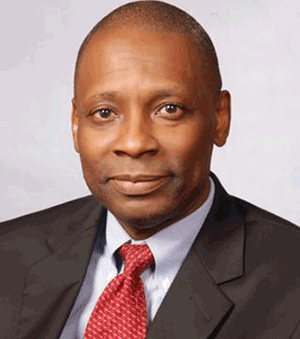Then Mustafa Chike-Obi was eased out of his plum job as Asset Management Corporation of Nigeria (AMCON) Managing Director on Tuesday, 18 August, he left a scorecard best described as mixed.

He targeted about 80 per cent recovery of loans, such that the mandate of AMCON would be close to 80 or 90 per cent done by 2016.
But it is far from achieving this as Chike-Obi left behind a N3.8 trillion debt stock in bonds held by the Central Bank of Nigeria (CBN).
The CBN is AMCON’s sole bond holder, according to Financial System Stability (FSS) report.
This debt is about 4.86 per cent of Gross Domestic Product (GDP) at N80.22 trillion and it is a huge risk and threat to sustainable growth.
Chike-Obi may have cleaned banking industry toxic assets of N5.6 trillion, but he also left liabilities of equal magnitude five years after.
Ahmed Kuru, former Enterprise Bank Group Managing Director, has taken over from him as the ‘bad bank’ new helmsman.
Kuru and his team of executive directors also inherited about 11,000 loans for recovery and about 1,000 unresolved court cases – including, perhaps, legacy issues and controversies over acquisition of the bridge banks in 2010.
The new team appointed on August 18 by President Muhammadu Buhari to run AMCON include Executive Directors, Kola Ayeye, Eberechukwu Uneze, and Aminu Ismail.
AMCON’s bond position
CBN’s FSS report showed that the apex bank is now only holder of a 6 per cent 2023 AMCON bond worth N3.80 trillion as of December last year.
Deputy Governor (FSS), O. J. Nnanna, said the bonds are expected to be progressively redeemed from contributions to the Banking Sector Resolution Cost Trust Fund and recoveries from AMCON’s operations.
AMCON acquired 12,537 non-performing loans (NPLs) across various sectors with total eligible banking assets (EBA) valued at N1.75 trillion.
Total amount of bonds redeemed since inception is put at N1.8 trillion.
According to the FSS report, AMCON’s total recoveries stood at N506.50 billion (28.94 per cent of total EBA of N1.75 trillion).
Cash recoveries stood at N201.37 billion (39.76 per cent), assets forfeiture was valued at N305.13 billion (60.24 per cent).
Real estate and other properties were valued at N191.82 billion, and securities at N113.31 billion.
A mandate half actualised
AMCON was established in July 2010 for three major objectives.
First, to relieve the banks of their NPLs following the banking sector crisis of 2008.
Second, to ensure banks are capitalised up to regulatory standards.
Third, to do all of this at minimum possible cost, maximising recoveries, minimising expenses, and maximising disposal of assets acquired.
The first mandate led to the purchase of EBA, which AMCON said it acquired at fair value in accordance with the valuation methodology prescribed in the guidelines.
The acquired assets, including the bridge banks, were put to economic use for the best achievable financial returns.
AMCON acquired about 12,537 NPLs across various sectors, including oil and gas, general commerce, capital markets, manufacturing, finance, and insurance.
As consideration for the NPLs purchased and capital acquired in eight banks, it issued bonds to banks worth about N5.6 trillion.
About N1.7 trillion of the bonds have been repaid, leaving a large portion of the instruments refinanced by the CBN in December 2013.
AMCON also acquired a significant number of underlying assets which were collaterals for the loans. They include shares in companies, real estate, bonds and other debt instruments, and assets.
About 27 per cent of the NPLs were said to be unsecured, leaving AMCON to pursue recovery or restructuring.
AMCON has adopted different approaches to realise its objectives, including restructuring of loan assets, loan workouts, instituting actions for debt recovery, conversion of debt to equity to secure control of debtor companies ahead of divestment, and forbearances.
AMCON achieved the priority mandate of recapitalising banks and relieving them of NPLs, but there is controversy on whether it recorded profit or loss in its operations.
More controversies
There is also controversy as to whether AMCON’s debt is part of gross national debt.
Biodun Adedipe, the Managing Director of Economic Associates, said the debt being a “contingent” liability to the government poses a huge risk and a threat to sustainable growth.
His words: “Nigeria’s fiscal framework is characterised by deficit budgets, high infrastructure deficit, high dependence on crude oil, low level of non-oil exports, and low non-oil revenue.
“Unmet debt obligations of AMCON that need refinancing will threaten government’s fiscal operations.”
However, the controversy about AMCON’s debt, equivalent to 56.53 per cent of national debt of N10.04 trillion as of December 2013, has been partially resolved since the CBN is its sole bondholder now.
On AMCON’s lifespan which was increased by another 10 years by the National Assembly in May this year, Adedipe said its continuing in operation in perpetuity is great inefficiency and a waste of taxpayers’ money.
In his view, AMCON will continue to incur high carrying cost from high operational costs as well as from the erosion in the value of assets not disposed and restructured over time.
“AMCON was conceived to operate for 10 years, but the enabling Act gave it life in perpetual succession. This is a departure from global best practices.
“The only distress resolution asset management company that has continuing life is NAMA of Ireland whose mandate is completely wider in scope than that of AMCON,” Adedipe made the point in a presentation obtained by TheNiche.
He said AMCON must have a well defined lifespan if it is to deliver its mandate successfuly.
However, Chike-Obi explained that “the plan for AMCON is 10 years for now. In 2023, we expect AMCON to be a very small entity.
“The reason why we said 10 years and not five years is because, for example, we hold about N300 billion of public stocks and the average trading volume is five billion a day.
“If you must sell it at the average of 2.5 billion a day, it will take many years to sell all the shares. So we take a longer time frame so that we can dispose of these shares.”
Purchase of banks’ performing loans
AMCON and CBN were also in the eye of the storm for compelling five banks to sell some of their performing loans worth N275 billion.
Under the claim that the loans involved were problematic, the CBN compelled First Bank to sell N100 billion debt owed by Seawolf Industries; Diamond Bank N25 billion debt owed by Geometric Power, while a consortium of Access Bank, Guaranty Trust Bank, and FCMB sold N150 billion debt owed the banks by Zenon Petroleum.
The sale of these eligible performing loans at a loss to AMCON partly accounted for the huge loan loss provisioning posted by banks for the year ended December 31, 2011.
Bisi Onasanya, First Bank Managing Director, told shareholders during the bank’s annual general meeting that the company is doing well.
He also explained that the loan is performing but that the CBN insisted that it be sold to AMCON due to its size because of the possible impact on the bank and the industry if the loan becomes non-performing.
“They forced us to sell the loan to AMCON and we took a haircut (loss) of 10 per cent. The loan was sold without recourse to First Bank,” he added.
Chike-Obi admitted that though the loans were performing, AMCON acquired them to take it off the books of banks.
“Zenon is owing N150 billion, Seawolf is owing N100 billion and Geometric Power N25 billion. These are good businesses, but the loans are too large and may pose systemic risk.
“These are not loans that are problematic. We just think they could be and we have to guide against that,” he explained.
Sinking fund controversy
The CBN and all banks agreed to establish a sinking fund, called the Banking Sector Resolution Cost Fund (BSRCF) to take care of distressed assets and low average rate of recovery.
The AMCON Act did not include the BSRCF originally. But with the AMCON Amendment Act 2013, banks bear the cost of intervention by contributing to the sinking fund that will pay the cost of AMCON’s intervention.
This sinking fund is to act as a credit enhancement and a form of security in the event that AMCON is unable to generate enough returns from loan assets to meet its obligations.
However, analysts described the sinking fund as an aberration which means that AMCON bought NPLs at a discount (banks took the loss on that) and negotiated restructuring terms that possibly included interest (and perhaps principal) forgiveness with the ‘bad debtors’, and will now make banks contribute to the fund that will pay the cost of AMCON’s intervention.
“The summary is that the borrowers in question ended up getting away with whatever discount AMCON obtained from the banks and the discount they subsequently obtained from AMCON.
“There is no successful ‘bad bank’ model that worked with this arrangement” one analyst insisted.
Chike-Obi countered that “when banks are collectively irresponsible, then they should be collectively responsible for the cleaning up of the mess.”














